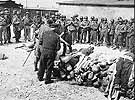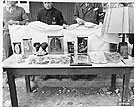
|
|
|

|

|

|

|
|
Click on an image to see a larger, more detailed picture.
|
|
|
|
|
| 1945: Liberation and Rebuilding |

|
pg. 593 |

|
|
|
|
| |
 U.S. Army soldiers gather around one of the numerous piles of corpses at the Buchenwald, Germany, concentration camp. The smell of rotting flesh was nauseating. U.S. GI John Glustrom said: "My first impression of [Buchenwald] was of the odor. The stench was all over the place, and there were a bunch of very bewildered, lost individuals who came to me pathetically at the door in their unkempt uniforms to see what we were doing and what was going to be done about them."
U.S. Army soldiers gather around one of the numerous piles of corpses at the Buchenwald, Germany, concentration camp. The smell of rotting flesh was nauseating. U.S. GI John Glustrom said: "My first impression of [Buchenwald] was of the odor. The stench was all over the place, and there were a bunch of very bewildered, lost individuals who came to me pathetically at the door in their unkempt uniforms to see what we were doing and what was going to be done about them."
Photo: Archive Photos
|
 Food rations at Buchenwald, which had never been sufficient for the heavy work required of the prisoners, shrank throughout the war. In March 1945, for example, inmates received 250 grams (a little over a half-pound) of horse meat per week. Prisoners sometimes stole food from the well-fed dogs that helped guard the camp. At the time of liberation, surviving prisoners raided a supply of dog biscuits kept in the camp's kennel. The man closest to the camera, a Hungarian Jew, was so thin that one can see his spine from above. Victims of such severe cases of starvation and malnutrition had little chance of survival.
Food rations at Buchenwald, which had never been sufficient for the heavy work required of the prisoners, shrank throughout the war. In March 1945, for example, inmates received 250 grams (a little over a half-pound) of horse meat per week. Prisoners sometimes stole food from the well-fed dogs that helped guard the camp. At the time of liberation, surviving prisoners raided a supply of dog biscuits kept in the camp's kennel. The man closest to the camera, a Hungarian Jew, was so thin that one can see his spine from above. Victims of such severe cases of starvation and malnutrition had little chance of survival.
Photo: Archive Photos
|
 The human remains on this table, including two shrunken heads and a lampshade allegedly made from human skin, were taken from a laboratory run by Buchenwald's SS guards. The commandant's wife, Ilse Koch, kept a collection of tattooed human skin. The two heads were those of Polish prisoners who had escaped and were recaptured.
The human remains on this table, including two shrunken heads and a lampshade allegedly made from human skin, were taken from a laboratory run by Buchenwald's SS guards. The commandant's wife, Ilse Koch, kept a collection of tattooed human skin. The two heads were those of Polish prisoners who had escaped and were recaptured.
Photo: National Archives/United States Holocaust Memorial Museum Photo Archive
|
|

|

|

|

|
 February 3, 1945: An American bomb crashes onto the Volksgerichtshof (People's Court) building in Berlin, killing fanatic Nazi judge Roland Freisler and interrupting the sentencing of anti-Nazi German Resistance members Frau Solf and her daughter, Gråfin Ballestrem; See September 10, 1943; April 23, 1945.
February 3, 1945: An American bomb crashes onto the Volksgerichtshof (People's Court) building in Berlin, killing fanatic Nazi judge Roland Freisler and interrupting the sentencing of anti-Nazi German Resistance members Frau Solf and her daughter, Gråfin Ballestrem; See September 10, 1943; April 23, 1945.
|
 February 4, 1945: An Allied conference at Yalta, Ukraine, establishes respective spheres of influence that will take effect at war's end.
February 4, 1945: An Allied conference at Yalta, Ukraine, establishes respective spheres of influence that will take effect at war's end.
|
 February 8, 1945: Soviet troops are 30 miles east of Dresden, Germany.
February 8, 1945: Soviet troops are 30 miles east of Dresden, Germany.
|
 February 13, 1945: German troops surrender Budapest, Hungary.
February 13, 1945: German troops surrender Budapest, Hungary.
|
 February 13, 1945: The SS evacuates the concentration camp at Gross-Rosen, Germany.
February 13, 1945: The SS evacuates the concentration camp at Gross-Rosen, Germany.
|
|
|
|
|
| 1945: Liberation and Rebuilding |

|
pg. 593 |

|
|
The Holocaust Chronicle
© 2009 Publications International, Ltd.
|
|
